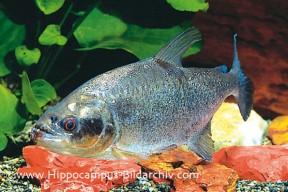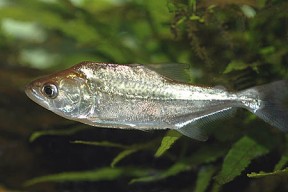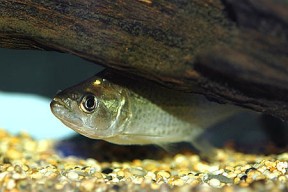Serrasalmus elongatus
Pike Piranha
Classification
Characidae. Subfamily: Serrasalminae
Distribution
Fairly widespread. It’s been recorded from Venezuela, Ecuador, Peru, Bolivia and Brazil, where it occurs in both the Amazon and Rio Orinoco river basins.
Habitat
This species is found in both black and white waters, inhabiting a diverse range of biotopes from areas of dense jungle to the tropical grasslands of the Venezuelan Llanos with their clear, sunlit water and lush growth of aquatic plants. Juveniles are particularly common around the so-called “floating meadows”. These ecologically-significant patches of semi-aquatic, floating vegetation (usually composed of grassy species) are a source of shelter and food for many fish species. Presumably the young use the cover to more easily ambush prey. Adults tend to move into the deep, flowing water of major river channels and have also been recorded in the seasonally flooded forests as well as permanent lakes.
Maximum Standard Length
Apparently it can grow to 12″/30cm, but captive specimens of this size are almost unheard of. It’s probable that this can be attributed to the fish being maintained in cramped conditions in many cases.
Aquarium SizeTop ↑
This is a very active fish so something in the region of 48″ x 24″ x 24″ /120cm x 60cm x 60cm/453 litres is the minimum that should be considered long-term.
Maintenance
Juveniles and newly-imported specimens are best kept in a planted set-up with plenty of shaded areas. A wild-looking tank decorated with tangles of roots and branches, clumps of plant species that grow to the water surface, patches of floating vegetation and a dark substrate is ideal. Many hobbyists keep their S. elongatus in rather bare set-ups but in our experience they can act a bit nervously when maintained like this and fare much better in more natural surroundings.
Adults live in open rivers and thus a well-oxygenated set-up with a sandy substrate and some good-sized driftwood roots and branches is more appropriate. The cover provided by the wood will be appreciated by this sometimes skittish species, as will the use of only dim to moderate lighting. Plants will tend not to thrive in these kind of conditions, but you could try some of the hardier species such as Vallisneria or Microsorium.
Water quality must be of the highest order for this fish to thrive, and a decent rate of flow seems to make it happier still. Use an external canister-style filter or sump, arranging the pipework so that water is returned lengthways along the tank. Place the spraybar so that it agitates the water surface a little. Additional powerheads are recommended by some sources but are not absolutely necessary if the tank is set up correctly. As usual when keeping large, predatory species weekly partial water changes of up to 50% are a must.
If possible the heaterstat should also be situated externally, as serrasalmids been known to attack both these and other items of equipment when they are located inside the tank. It’s possible to buy external filters with built-in heater elements, or inline units that can be fitted to the filter pipework. Failing these a sturdy heater-guard should be considered a minimum requirement.
Water Conditions
Temperature: 24 – 28°C/75 – 82°F
pH: Best kept in slightly acidic to neutral conditions. The pH in the Rio Orinoco ranges from 4.5 – 7.0 depending on locality.
Hardness: Up to 15°
Diet
Stomach anlayses of wild fish suggest it is an exclusive carnivore, the diet being composed of smaller fish and various invertebrates. It’s known to feed heavily on the fins and scales of other species. In the aquarium most individuals can be weaned onto dead foods over time, although some seem to find it trickier to adjust than others and may refuse to feed initially. A period of starvation may be necessary, eventually giving the fish little choice but to accept what is offered. This is especially true of larger or recently-transported specimens.
Once acclimatised juveniles relish live or frozen bloodworm, Tubifex, Artemia, chopped prawns and similar foods. Adults should be fed correspondingly larger items, such as whole mussels, cockles, prawns, chopped squid, whitebait and earthworms. Once the fish reaches adult size it need only be fed two or three times a week.
This species should not be fed large amounts of mammalian/avian meat such as beef heart or chicken. Some of the lipids contained in these meats cannot be properly metabolised by the fish, and can cause excess deposits of fat and even organ degeneration. Similarly there is no benefit in the use of ‘feeder’ fish such as livebearers or small goldfish. Risks involved with these include the possible introduction of disease or parasites.
Behaviour and CompatibilityTop ↑
Should only be considered as a specimen fish for the enthusiast. This species doesn’t make a good tankmate for anything else. Scattered reports of it coexisting with other species should be considered tenuous at best given its natural diet. Similarly there is little point attempting to keep two or more of these together. It is not a gregarious animal by nature and conspecifics are liable to fight until only one remains.
Sexual Dimorphism
Unknown. There has been speculation that variations in the shape of the anal fin or caudal peducle patterning may be an indicator of gender, but to date neither of these theories have been confirmed by science.
Reproduction
Like most members of the genus, S. elongatus has not been spawned in captivity.
NotesTop ↑
S. elongatus is known as “Caribe Pinche” in its native countries and is a rare find in the trade, tending to be quite expensive as a result. Individuals seem to vary in personality. While some are particularly fearless and will actively chase and attempt to bite hands or fingers placed in or up against the aquarium, others will always appear to be shy and nervous. The streamlined body form that gives rise to the species name is unique among serrasalmids, and has probably developed as an adaptation to the fast-flowing waters that this fish calls home. Interestingly much of this shape is lost as the fish mature, with really big adults filling out into a more diamond-shaped figure. The extent to which this occurs appears to be based at least in part on the locality of the fish.
There are currently 24 described species of Serrasalmus, many of which look superficially similar. Due to its shape S. elongatus is possibly the easiest of these to identify correctly. It is usually placed into the so-called “humeralis group” by experts. This grouping of morphologically similar species was first proposed by Géry in 1976 and also contains S. humeralis and S. gibbus. It was originally included in the group as S. pingke, a name now known to be a junior synonym of elongatus. It’s possible that S. gibbus may also prove invalid in the future, with some evidence suggesting it might be a geographical form of S. rhombeus.
S. elongatus itself exists in at least two different forms, one (known as the “black mask” variant in hobbyist circles) develops an impressive thick black stripe that runs through the eye of the fish, extending to the operculum. It also possesses a dark humeral spot and has an overall silvery body colour. The other form exhibits bright orange/red pigmentation in the pectoral fins, throat and lower portion of the operculum, and usually has a darker head and fins than the black mask variant. Apparently there are also some small differences in body girth between the forms.
Most experts agree that a detailed revision of Serrasalmus is necessary, as historically the genus has been viewed as something of a “catch-all” for similar-looking fin-biting/predatory characins. The juvenile forms of numerous species look broadly similar, characteristically developing the more distinctive adult patterning as they mature. This has resulted in new species being erected erroneously and there have been several attempts to reorganise the group. The most recent major revision was undertaken by Géry in the late 1970s, but a handful of new species have been described since then.
It’s worth noting that in South America only Pygocentrus species such as the infamous red-bellied P. nattereri are known as piranha, with Serrasalmus and other related genera being referred to by other names such as Pirambeba. Serrasalmus species are therefore not considered to be “true” piranhas, the name being applied to them by the English-speaking world and aquatic hobby. The relationship between these genera is too complex to address here, although when observing mature fish clear morphological differences are apparent. In his 1991 revision of Pygocentrus Fink stated the following:
“Relative to other serrasalmin, Pygocentrus is diagnosable by several features, including prepelvic serrae number, morphology of the gas bladder and skull, and head width.”
It should also be said that serrasalmids are not the fearsome “monster fish” as often depicted by the media. Obvious care must be taken when performing tank maintenace but these fish will usually only bite when threatened, and they can be quite skittish in an aquarium setting unless their rather specialist needs are catered for. Most also live in excess of ten years and become less active as they mature, so think carefully before buying one.




